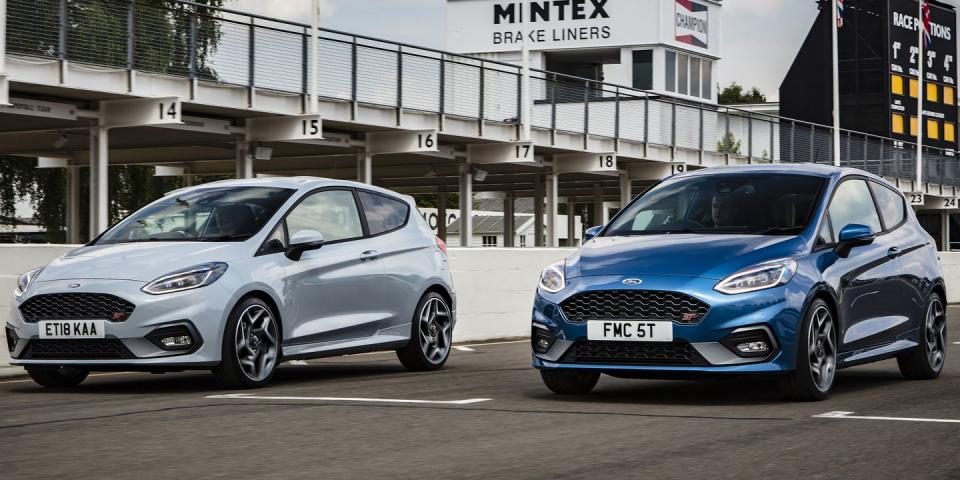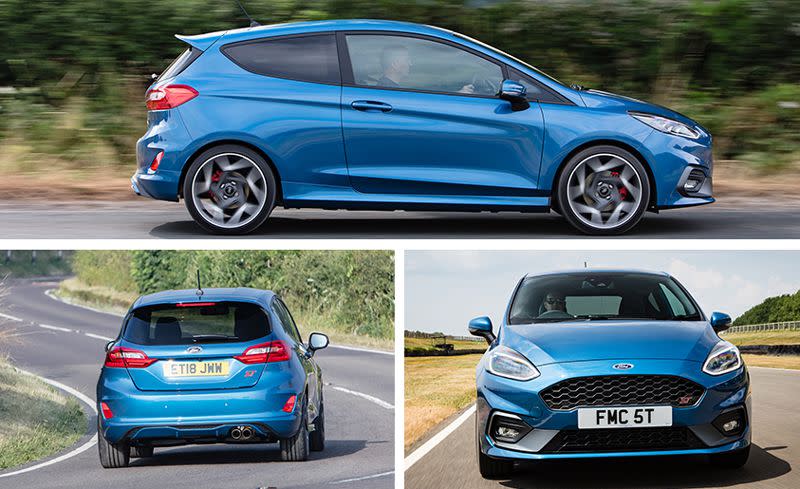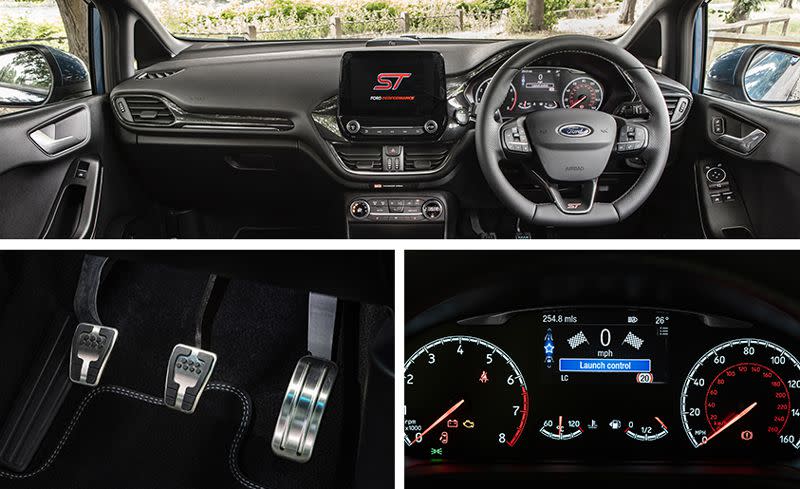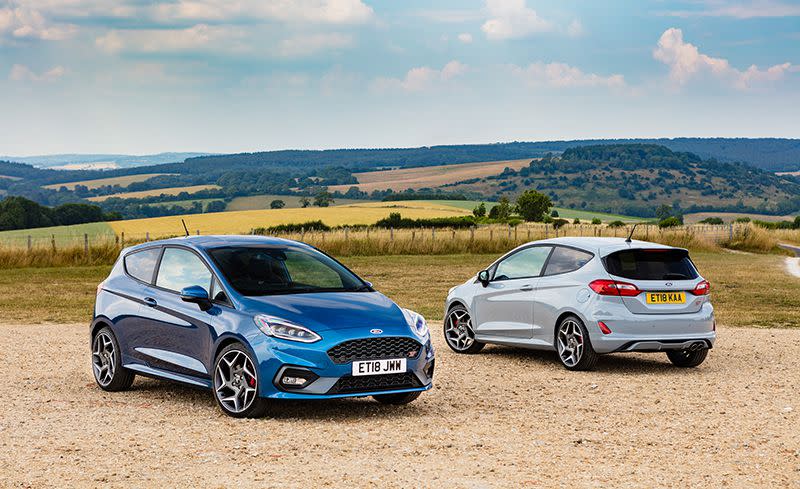The New Ford Fiesta ST Has a Smaller Engine, Is Even More Fun

The guiding principle of the materialistic world we live in is that more of something good equals something better. This irrefutable logic applies to automotive attributes in the same way as it does to doughnuts and churros. Especially so with regard to engines, where more always seems like the right answer.
Yet with the new Ford Fiesta ST and its new turbocharged inline-three, the rule fractures. A new car can't be better than its predecessor while packing 25 percent fewer cylinders, can it? That reduction would never seem acceptable in a soda serving or a potato chip portion, let alone a performance car. Yet we can confirm that the new Fiesta ST-and its tiny turbocharged triple-does indeed feel like a significant upgrade over the 2018 car, which has a full quartet of cylinders under the hood.
While the outgoing 2018 Fiesta can still be purchased, new, from some Ford dealers in the United States, global economics and the crossover-ification of the U.S. auto industry have turned this next edition into a moot point for Americans. Ford's decision to give up on trying to sell the parts of its portfolio that we would previously have categorized as "ordinary cars" in the States is going to deny us all versions of the new seventh-generation Fiesta. We can gaze upon it enviously only from afar; our first drive of the ST took place in the United Kingdom.
Same Power from Only Three Cylinders
The decision to design the seventh-generation Fiesta around a range of three-cylinder engines raised the question of how Ford would create a successor to the current ST and its turbocharged 1.6-liter four-banger. The answer was to create a punchier version of its three-pot EcoBoost, a new 1.5-liter unit boasting an identical 197 horsepower and more torque than the old engine. The latter has risen to 214 lb-ft, an increase of 12 lb-ft, with that peak now available from 1600 to 4000 rpm. A six-speed manual gearbox remains the only transmission choice, while a limited-slip differential is a new option.
Our first encounter with the new ST took place at the Goodwood Motor Circuit in the south of England, where Ford proclaimed its confidence in its new performance baby by offering the unusual prospect of an open pit lane. Media track-driving events are often done either under one-to-one instruction with a passenger as likely to shout "brake!" as would be your aged auntie, or by following a pace-setting leader. But other than limiting sessions to six laps at a time to preserve brakes and tires, Ford gave us free rein of one of Europe's fastest circuits without restrictions beyond a chicane to break up the long Lavant straight and a polite request that we not crash.
Sitting on the same base architecture as the outgoing ST, and with a similar chassis of struts for the front axle and a torsion beam at the rear, it's no surprise that the new Fiesta showed much of the same verve and enthusiasm as its antecedent. Spring rates have increased by around 10 percent, and the new car features a steering rack that Ford says is about 14 percent quicker than the one on the Europe-only ST200 that we drove two years ago. On track it turned keenly, gripped tenaciously, and, on Goodwood's few tight corners, proved willing to adjust its line to an amusing degree while never feeling snappish or skittish. As with the Focus ST and RS models, the Fiesta ST has gained selectable driving modes, with the most aggressive Track setting disabling the stability control and adding some more exhaust noise. It certainly made some pleasingly determined sounds as the tach needle approached the red zone, with the three-cylinder occasionally producing some Porsche-like harmonics to remind us that three is halfway to six. Beyond the reduction in spark plugs, it's hard to think of anything that the three lacks compared to the four.
The six-speed gearbox again is the highlight of the driving experience, being effectively unchanged from the current car. Ford remains able to give even humble models a nicer and more accurate action than you'll find in many cars costing several multiples of the ST's price. Upshifts and downshifts are a tactile pleasure, the latter helped by pedal positioning ideally suited for heel-and-toe rev-matching. The only real issue obvious at the end of our track stints was some brake fade under hard use; that, and the desire for another 100 horses to help shorten the straights.
More Mature on the Road
While it is able to match the rawness of the current ST's thrills, on the road the new car feels considerably more grown up. The cabin is responsible for a large part of this mature feel, with more space for occupants in both front and rear and a switch to higher-grade materials for the parts of the interior that are regularly touched. Fancier versions also boast Ford's latest Sync 3 infotainment system and an 8.0-inch touchscreen display, with even the base model getting a 6.5-inch touchscreen. Both two- and four-door hatchbacks will be offered; previously Europe only got a two-door version of the ST, while the American model could be had only with four doors. The driving position is improved, too, with the huggy Recaro sport seats offering a greater range of adjustment, including the ability to be set lower than in the current ST, which can feel like a car you sit on rather than in.
Although cruising refinement is respectable, the ST still rides on the firm side of comfortable and gets jiggly on rough surfaces at low speeds. The engine can also become droney when operating at constant revs. The EcoBoost can turn itself into a two-cylinder under gentle use, deactivating cylinder number one to improve fuel economy. Ford says it can switch back into a full triple in just 14 milliseconds, which it does in response to any significant throttle input. From the driver's seat there's effectively no way to tell when the engine is running as a bongo drummer.
Our soon-to-die ST has always been a terrier of a car, hugely enthusiastic even when you might not want that at the moment. The new one feels bigger and slightly more sensible in everyday driving, while still able to turn into a raging purple minion when ordered to do so. In terms of positioning, it feels closer to the equally doomed Focus ST than to the previous Fiesta.
European buyers' willingness to dig deeper for entry-level performance cars explains the increase in quality. Based on current exchange rates, the new Fiesta ST starts at about $20,400 in England. That's enough of an increase to make the remaining dealer stock of 2018 models look like an even more compelling value.
While we regret being denied the new ST, we're still glad that Ford has the engineering smarts to make something this good. Here's hoping that some part of its spirit translates to the ST-badged crossovers that we will be getting in America.
('You Might Also Like',)

 Yahoo Autos
Yahoo Autos 



